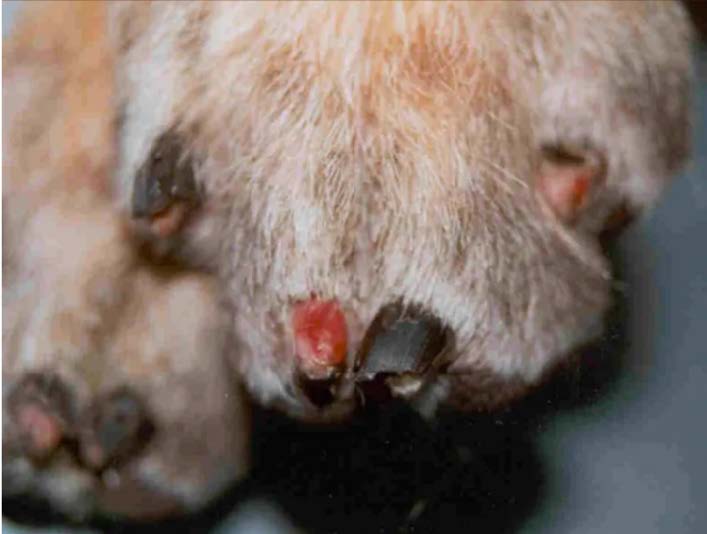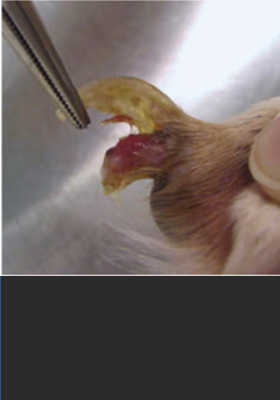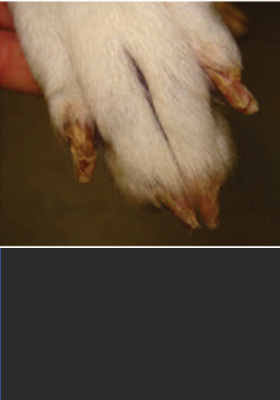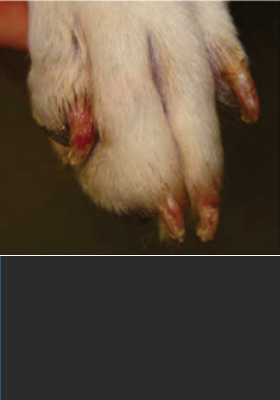by Dr. Belinda Oppenheimer BVSc (Hons) MANZCVS

SLO, short for Symmetrical Lupoid Onchodystrophy, is a rare disease of dogs affecting the nails of the paws. While a very uncommon condition, certain breeds appear predisposed, including the greyhound.
SLO is an autoimmune condition. It can be thought of as a highly specific version of lupus in humans, in which the body attacks the tissues of the nail bed in affected dogs. This causes the nails to become deformed: they may be seen lifting away, coming away altogether, may appear inflamed or ooze discharge (usually due to secondary infection), and regrow abnormally twisted, split, brittle or otherwise distorted.
This disease is unique in that only the nails are affected; the skin and other organs are not impacted by the disease, though your greyhound may be pained and irritated due to paw discomfort. Please attend your veterinarian if you are concerned about your greyhound’s feet. It may be worth mentioning SLO if your veterinarian is less familiar with the breed.
While bacterial and fungal nail infections are much more common than SLO when more than one nail is affected, especially on more than one paw, the chances of an SLO diagnosis increase.
Your vet will likely perform some diagnostic testing to rule out infection, such as taking a swab to look under the microscope and try and culture bacteria and fungi, and radiographs if the toes are swollen.
Sadly, the only way to confirm a diagnosis of SLO is via biopsy: this involves the surgical amputation of part of a toe. As such, many elect to treat for SLO and assess the response prior to considering this more invasive option, especially considering the uniquely characteristic signs of the disease.
What causes SLO?
While no cause for SLO has been established, genetics are suspected. As nothing can be done directly to treat the body’s malfunctioning immune system, treatment is aimed at controlling signs.
The good news is that the disease is usually readily controlled with medication, and affected greyhounds invariably go on to live a full, quality life.
No treatment has proven perfect, and the right treatment regimen will vary with each greyhound, owner and veterinarian team!

Separation of the claw from the claw bed 
New claws are very brittle. All claws are involved. 
One recently sloughed claw next to three regrowing nails.
Treatment options
Treatment options may involve one or more of the following: supplementation with fatty acids and vitamin E to support the nailbed, medications to suppress and alter the immune system, antibiotics, and anti- inflammatories to reduce pain and further suppress the immune system.
Affected nails are generally recommended to be trimmed frequently to reduce the risk of further breakage, and occasionally, loose nails will need removing under anaesthesia on welfare grounds. It may take several months to see treatment having an effect and the protocol may need to be altered based on how the individual dog responds. Even with a good response, treatment is usually continued for a minimum of six months, and may need to be continued lifelong to keep the immune response at bay.
SLO is one of the diseases greyhounds are more prone to, but given its thankful rarity, and excellent prognosis with medical control, we shouldn’t let it ‘slo’ our furkids down!
This article appeared in Issue 10 of Greyhound Life Matters, the quarterly ezine published by the Coalition for the Protection of Greyhounds. Click here https://greyhoundcoalition.com/newsletter/ to view all editions of the ezine featuring articles from a great range of people with experience in all aspects of greyhound lives. You can also sign up and get Greyhound Life Matters direct to your inbox.
References
- Excellence in Dermatology. 2014. Lupoid Onchodystrophy. https://www.zoetis.ca/conditions/dogs/dermatology/lupoid-onychodystrophy.aspx. Accessed 30 August 2020.
- Waisglass, S. 2018. Claw disease in the dog: Does your patient have symmetrical lupoid onchodystrophy (SLO)? Can Vet J. 2018 Jul; 59(7): 796 – 798.
- Thompson, LA. 2019. How I Treat Lupoid Onchodystrophy. Proceedings of the NAVC Conference 2012 Small Animal.